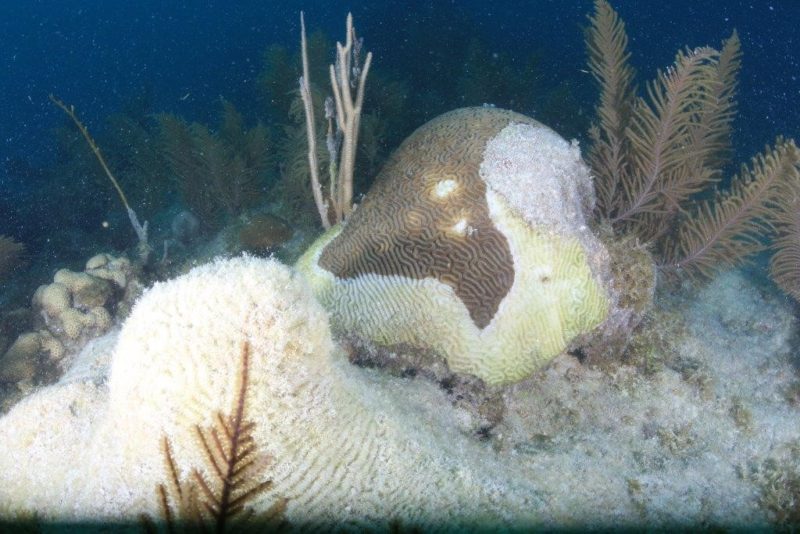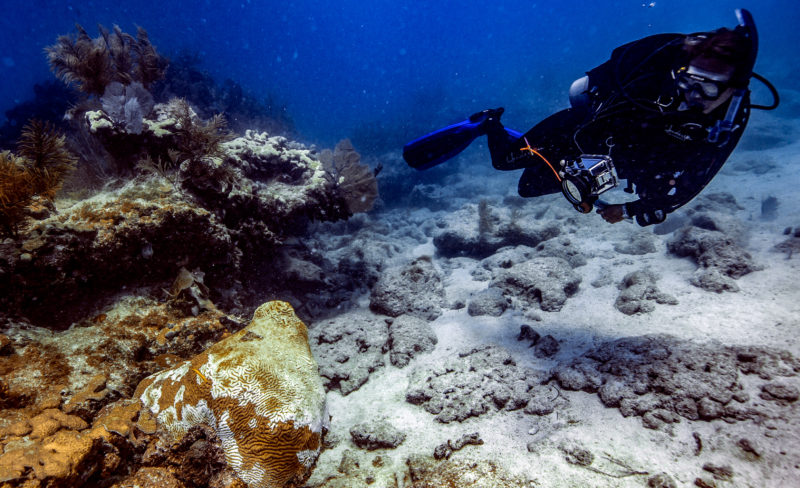Parts of Florida and the Caribbean are currently suffering from a historic, ecosystem-altering coral disease outbreak. The situation is eliciting an unprecedented response from scientists, resource managers and the public in Florida. Here, divers have the opportunity to contribute to an extraordinary effort to research, remediate and restore damaged coral.
Stony-coral tissue loss disease

Recent death of the brain coral in the foreground indicates the coral next to it will likely suffer the same fate from stony-coral tissue loss disease. Credit: Greg McFall/NOAA
Stony-coral tissue loss disease first appeared in a chronically-stressed region near Miami in 2014. Soon after, it rapidly spread to the upper reaches of the Florida Reef Tract and south into the protected waters of Florida Keys National Marine Sanctuary. By early 2019, the highly lethal disease reached the outer reefs off Key West with reports of a similar outbreak in Mexico, Jamaica, St. Maarten, and the U.S. Virgin Islands.
Unlike white plague and other common coral disease, stony-coral tissue loss disease affects 22 species — half the hard-coral species in Florida. This presents a serious setback for reefs already suffering from climate change, ocean acidification, pollution, fishing pressures, and other increasing human interaction.
Response to the outbreak

Science divers monitor progression of stony coral tissue loss disease in Florida Keys National Marine Sanctuary. Credit: Nick Zachar/NOAA
The aggressive response to this ecosystem-altering event involves an unparalleled collaboration of government agencies, academic institutions, and nonprofit organizations. All are working together to document the outbreak, identify likely causes, understand contributing environmental factors, and develop innovative treatments to slow or stop the disease. In the meantime, they’re attempting to rescue healthy, genetically-diverse corals for future restoration.
“Nowhere in the world have there been this many organizations coming together focused on a coral disease event,” says Dr. Andrew Bruckner, research coordinator at Florida Keys National Marine Sanctuary. “That tells you that there is intense concern about the ecological and economic impacts that stony coral tissue loss disease could have here in Florida and beyond.”
What’s at stake
Southeast Florida’s coral-reef ecosystem supports more than 71,000 jobs and $6.4 billion in sales and income annually. In the Florida Keys, approximately 60 percent of all jobs are tied to the marine ecosystem including diving, boating, recreational and commercial fishing, and tourism. The continental United States’ only coral barrier reef also presents a natural buffer, lessening the strength of waves and protecting human life and property.
There is still much to learn about stony-coral tissue loss disease, and investigation is ongoing. Researchers believe the pathogen is a bacteria transmitted through water circulation and touch. Until they are able to determine the pathogen, it is difficult to confirm that a similar outbreak in the Caribbean and Mexico is the same disease afflicting Florida reefs.
What can divers do?
Divers are urged to use proper diving techniques. Crucially, they must decontaminate dive gear between dives as well as before and after each dive excursion, especially when traveling between countries or between infected and uninfected sites.
Decontaminating dive gear
First, remove debris and sediment following each dive. With a bleach solution, sanitize non-sensitive gear that contacts corals. Wash other gear in fresh water and use antibacterial soap. Use quaternary ammonium solutions to decontaminate dive gear after you return to shore.
For BCD internal bladders, pour approximately ½-liter of disinfecting solution into the mouthpiece of the exhaust hose while depressing the exhaust button. Inflate the BC, and gently rotate in all directions. Allow it to sit for 10 minutes and flush twice with fresh water. Soak regulators, computers, gauges, underwater cameras and other sensitive equipment for 20 minutes in a solution of warm water and antibacterial dish soap. Rinse in fresh water and air dry. Additionally, or alternately, thoroughly wipe with isopropyl alcohol.
It is important to always properly dispose of disinfectant solutions and rinse water in a sink, tub or shower. Never pour into the ocean or a storm drain.
Coral condition reporting
Divers in Florida can help report coral conditions to the Southeast Florida Action Network (SEAFAN), the Florida Department of Environmental Protection’s public reporting tool. Observations greatly enhance scientific knowledge of disease presence while also helping to identify key areas for targeted research and interventions. Reports of healthy corals help identify particularly valuable and resilient reefs. Identifying tags are placed on some treated corals on the Florida Reef Tract, encouraging divers to upload photos.
Florida Sea Grant agents in South Florida are training recreational divers to properly identify stony-coral tissue loss disease and conduct surveys to monitor disease progression and coral recovery. There is an optional dive after each free training session.
Relieving Stress
In order for restoration to be successful, we must relieve stress on the marine ecosystem. We must improve water quality, reduce runoff and keep trash contained. Use reef-friendly sunscreen and wear sun-protection clothing to reduce the need for sunscreen. Practice safe boating, including using mooring buoys to avoid anchor damage. And if you must eat fish, opt for sustainable seafood to address the issue of overfishing.
Expand Your Education
Coral reefs cover less than one percent of the Earth’s surface. However, they are home to 25 percent of all marine fish species. Coral diseases are increasing in frequency, intensity, and geographic range. A plethora of information about corals exists online from NOAA and other valid sources. For specifics on stony-coral tissue loss disease, including ways that you can help, visit the Florida Keys National Marine Sanctuary’s website.
By guest author Gena Parsons, National Marine Sanctuary Foundation Communications and Outreach Manager
The post Coral Disease Outbreak Affects Florida and Caribbean appeared first on Scuba Diver Life.
from Scuba Diver Life https://ift.tt/2U80bh3
No comments:
Post a Comment